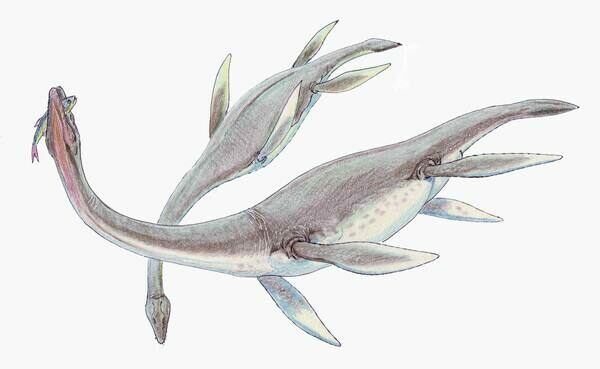This Specimen has been sold.
7" Plesiosaur Humerus Bone on Ammonite Stand - Asfla, Morocco
This is a very interesting ammonite and plesiosaur fossil display, all of which were collected from locations near Goulmima, Morocco. It features a 7" long humerus from a plesiosaur, perched atop half of an ammonite fossil of the genus Mammites. The entire specimen stands 7.1" tall.
Plesiosaurs were aquatic reptiles. They had small heads, long necks, broad, flattened bodies, short tails and large flippers or paddles. They are one of the best described groups of fossil animals with a total of 110 known species, many from complete or nearly complete fossils. The largest known is Elasmosaurus at 40 feet (12 meters), and the smallest was Thalassiodracon at just under 6 feet (1.5 meters). They first appear in the fossil record near the end of the Triassic Period, starting with Thalassiodracon from about 203 million years ago. They disappear from the fossil record about the time of the Cretaceous-Paleogene Extinction, along with the dinosaurs and most other reptiles.
Plesiosaurs were almost comical in their appearance: small heads full of sharp, cylindrical teeth; wide, comparatively flat bodies; short tails; and four large paddles or flippers. They are so odd-looking that when originally found, the first Plesiosaur fossil was mistaken for a new kid of Pterosaur. Even when the first Plesiosaur went on display, it had its head mounted on the wrong end! Plesiosaur necks could also have large numbers of vertebrae: Albertonectes had 72 in its neck!
Plesiosaurs swam by moving their paddles or flippers in much the same way that modern sea turtles do. This would have made them efficient and maneuverable, but not particularly speedy. Due to their long, thin necks and flippers, it is unlikely that Plesiosaurs left the water. If they did, they would not have been able to travel far. It had long been thought that Plesiosaurs left the water to lay eggs in much the same way as modern sea turtles. Recent evidence seems to prove they bore live young, making theories that they left the water less likely. It is widely held that plesiosaurs were not the fastest swimmers in the sea, cruising to catch their preys of various fish, squid, and other mollusks.
Plesiosaur fossils have been found worldwide. The first described fossil was found in Kansas. Since then, they have been found on every continent. Most commercially available Plesiosaur fossils come from Morocco and Kansas.
Plesiosaurs were almost comical in their appearance: small heads full of sharp, cylindrical teeth; wide, comparatively flat bodies; short tails; and four large paddles or flippers. They are so odd-looking that when originally found, the first Plesiosaur fossil was mistaken for a new kid of Pterosaur. Even when the first Plesiosaur went on display, it had its head mounted on the wrong end! Plesiosaur necks could also have large numbers of vertebrae: Albertonectes had 72 in its neck!
Plesiosaurs swam by moving their paddles or flippers in much the same way that modern sea turtles do. This would have made them efficient and maneuverable, but not particularly speedy. Due to their long, thin necks and flippers, it is unlikely that Plesiosaurs left the water. If they did, they would not have been able to travel far. It had long been thought that Plesiosaurs left the water to lay eggs in much the same way as modern sea turtles. Recent evidence seems to prove they bore live young, making theories that they left the water less likely. It is widely held that plesiosaurs were not the fastest swimmers in the sea, cruising to catch their preys of various fish, squid, and other mollusks.
Plesiosaur fossils have been found worldwide. The first described fossil was found in Kansas. Since then, they have been found on every continent. Most commercially available Plesiosaur fossils come from Morocco and Kansas.
About Ammonites
Ammonites were ancient marine cephalopods, similar to today's squids and octopuses, but with a defining feature: their distinctive, tightly coiled spiral shells. These shells, resembling those of modern nautiluses, served as both a protective home and a buoyancy aid, allowing ammonites to navigate the prehistoric seas with ease. First emerging around 240 million years ago in the Triassic Period, ammonites thrived for over 175 million years, adapting through numerous forms and sizes. As predatory creatures, they likely fed on smaller marine organisms, using their tentacles to capture prey. However, their long reign came to an end 65 million years ago at the close of the Cretaceous, coinciding with the mass extinction event that also eliminated the dinosaurs.
Ammonites were ancient marine cephalopods, similar to today's squids and octopuses, but with a defining feature: their distinctive, tightly coiled spiral shells. These shells, resembling those of modern nautiluses, served as both a protective home and a buoyancy aid, allowing ammonites to navigate the prehistoric seas with ease. First emerging around 240 million years ago in the Triassic Period, ammonites thrived for over 175 million years, adapting through numerous forms and sizes. As predatory creatures, they likely fed on smaller marine organisms, using their tentacles to capture prey. However, their long reign came to an end 65 million years ago at the close of the Cretaceous, coinciding with the mass extinction event that also eliminated the dinosaurs.
SPECIES
Unidentified Plesiosaur & Mammites sp. (Ammonite)
LOCATION
Asfla, Near Goulmima, Morocco
SIZE
Humerus: 7 x 3.9", Ammonite: 5.2" wide, On Stand: 7.1" tall
CATEGORY
SUB CATEGORY
ITEM
#252373
We guarantee the authenticity of all of our specimens.
 Reviews
Reviews













